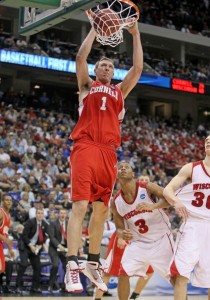NCAA Tournament Sweet 16: Where Seed No Longer Matters

Northern Iowa is just one of several lower seeds that have crashed the party at the 2010 NCAA Tournament.
Whew, it is finally time to catch your breath after an amazing weekend of college basketball in the first two rounds of the Division I Men’s Championship.
As could be expected considering the lack of great play among the top conferences this season, the opening games included lots of surprises and big names going home early.
Below are some observations from the opening rounds:
REVENGE OF THE MID-MAJORS: Much has been written in recent years about how the five BCS conferences seem determined to conquer the college sports world. They have made it almost impossible for a non-BCS league school to win the College Football Championship and have also done everything possible to ensure that as much money from the NCAA Men’s Basketball Tournament stays with the big boys as possible.
Until this season, the number of at-large teams in the tournament from non-BCS schools had been making a significant decline in recent years. That number increased to eight this year (after only four a year ago), but part of that reason was that the BCS leagues (especially the Pac 10) were appreciably weaker than in recent years.
Will a Non-BCS Conference Team Reach the Final Four?
- Yes (77%, 10 Votes)
- No (23%, 3 Votes)
Total Voters: 13
It should be obvious from the opening weekend that while major conference college basketball is not as strong in 2010 as in past years, the mid-major conferences are as strong as ever and deserve to be noticed and appreciated.
Throwing out opening round matchups between BCS and non-BCS schools that featured the top three seeds from each region, there have been a total of 20 games in the tournament featuring a BCS conference school against a non-BCS school.
Given how superior most college basketball analysts want us to believe the BCS conferences are, you would expect the record to not be close. However, BCS schools have won only 11 of the 20 total matchups. They were 6-5 against non-BCS schools in the opening round and 5-4 in the second round.
Experts have anointed the Big East as the best conference in college basketball, but their teams struggled against non-BCS teams. Georgetown lost to Ohio in the opening round and Villanova barely defeated Robert Morris before losing to St. Mary’s. Pittsburgh and Notre Dame were also eliminated by schools from non-BCS leagues.
When BCS schools face non-BCS opponents in the regular season the games are generally played at the BCS-school and come with all the trapping of a home game including gym familiarity, home crowd and officials from the host conference.
In the NCAA Tournament, those trappings are no longer present and the fact that in games of seeds four through 13 the BCS schools hold only a slim lead shows that there is much more parity in college basketball than the experts who rely on the support of the big conferences would lead you to believe.
With five non-BCS league schools among the final 16 and at least one in each region, this could mark the third year in the last five (George Mason in 2006, Memphis in 2008) that a non-BCS school crashes the big boys final four party.
SEEDING DOESN’T MATTER: While mid-majors have been the big winner in the tournament, lower seeds in general (regardless of conference) have performed well in the first two rounds.
Ten teams seeded ninth or lower advanced to the second round and eight teams seeded fifth or worse are still dancing.
As a number 12 seed, Cornell is the lowest remaining seed and arguably the greatest story of the tournament. The Big Red are a senior laden squad that has been building for this moment for four years and have risen to the occasions.

Cornell didn't look like a 12 seed in their dominating win over Wisconsin.
After defeating Temple and Wisconsin they will be facing top seeded Kentucky in a game that will be played only about an hour from their campus.
That a 14 and 13 seed each won a game in the tournament and that there remains a 9, 10, 11 and 12 seed in the final 16 illustrates that the margin between teams in the tournament this year was miniscule.
It will still be a challenge for a lower seed to reach the Final Four, but there certainly seems a likelihood that at least one team seeded 5th or lower will still be playing when the Final Four tips off on April 3rd.
WE PICKED THE WRONG NUMBER ONE: With 40% of all participants in the ESPN Bracket Challenge selecting them to win the title, Kansas was a significantly greater tournament favorite than North Carolina (28%) was a year ago.
In a year when it seemed apparent that there was no really dominant team, Kansas did show signs of being that one team you could count on being there at the end.
Of course, that ended with their upset at the hands of Northern Iowa.
It now is evident that while the Jayhawks were very good, they did have flaws that were exploited by the upstarts from the Missouri Valley Conference.
While the Jayhawks were defeated in the second round, the other three top seeds all looked dominant in advancing to the Sweet 16.
In fact, while lower seeds gave just about every other higher seed in the tournament fits, the three remaining number one seeds all posted easy double digit wins in both of their games. The 15 point victory by Duke over California was the closest game amongst the top three in the second round.
There will not be four number one seeds in the tournament, but there very well could be three number ones in the building when the Final Four plays in Indianapolis.













